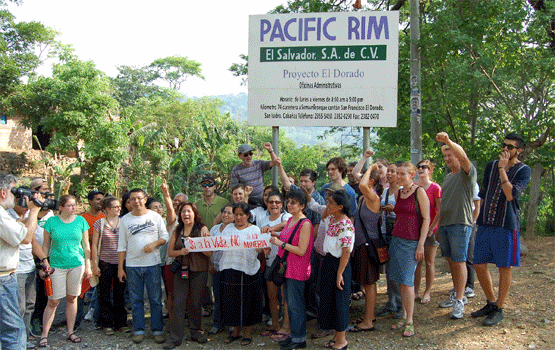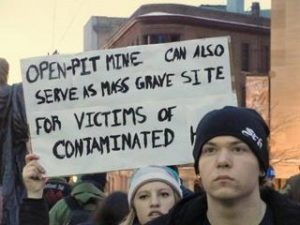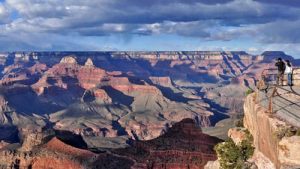Defending Natural Resources, Online Resources
A Compelling History of Mining in El Salvador, Jan 2010
Everything has to do with Pacific Rim and the company’s longing to exploit the gold found underground in the department of Cabañas. Almost from the time that the company set up in said zone, conflicts began, whose biggest opponent is the resistance of the communities to sell their land, and prevent the negative environmental impacts that gold extraction would bring. This resistance, to the surprise of locals and foreigners, has national and international support, but, in spite of this, they couldn’t prevent the crimes against three activists associated with the Cabañas Environmental Committee, crimes that were predicted and because of this show a certain level of negligence on the part of the government in protecting those threatened.
The following article is a collection of pieces found in diverse sources of information, so that that the citizenry may have a very clear grasp of the current panorama and an understanding of the engine that moves Pacific Rim’s actions, which is a engine whose timeframes and ambitions are not for the benefit of El Salvador.
Underground treasure in Cabañas
In a recent interview, Rob McEwen, the executive director of U.S. Gold Corp, said: “Gold is money, it’s currency. Gold is only used as currency in times when there are economic problems and we are in one of those times- one of three in the last 110 years. Towards the end of 2010, I see the price of gold as 2,000 dollars and before the game is over more than 5,000 dollars. Annual mineral production is declining and the costs are rising, this means higher prices. A gold supply deficit and the printing of money by Governments will probably propel the increase in price of gold to 2,000 dollars an ounce at the end of next year 2010 to and over 5,000 dollars between 2012 and 2014. I think that our governments will be printing more money and the dollar will buy less.”
The transnational mining company Pacific Rim knows this, and has cast its glance on the treasure found below the subsoil in the town of San Isidro, in the department of Cabañas, El Salvadorr: 1.2 million ounces of high purity gold, and more than 7.5 million ounces of silver. The estimates at the beginning o of 2010 are for $1,100.00 per ounce of gold; and $17.60 for silver. More than two million dollars.
Pacific Rim’s reports add: “There are still another 558 thousand ounces [of gold] and 1.2 million ounces of silver in the inferred category.”
According to the geological study: “it’s considered that in El Salvador, compared with other more advanced countries in the world, the Gold Belt is beginning to be discovered and has a large potential that could mean up to tens of millions of ounces of gold”.
With the price of gold almost tripling since 2001, the company assured its stockholders, that by finding “abundant levels of gold” and signs of “exciting gold discoveries,” this would expand their future investment opportunities with a very high yield, writes Emily Schwartz Greco, in her article “The Fight for Gold in El Salvador” published in the magazine Foreign Policy in Focus.
Above the treasure
Pacific Rim began to explore the gold exploitation potential of the country seven years ago, tracing the vein system that covers considerable portions of Northern El Salvador. The company began its operations invited by the Ministry of Environment and Natural Resources (MAR), who gave exploration permits in 2002 under the neoliberal administration of Francisco Flores. Since then, the corporation has identified some 25 sites for gold extraction in seven departments, investing more than $80 million.
The gold deposits that Pacific Rim intends to explore are located in an area that they themselves describe thus: “The land around El Dorado (the name of the mine) like the majority of the country is devastated by excessive deforestation and the extensive burning as a result of subsistence agricultural. During the rainy season, planting increases and therefore so does the use of chemical defoliants, that eliminates weeds so that they don’t impede the crop growth. The primary crops are corn, beans and sorghum. Departments are the main poltical-terriorial divisions of the country and El Dorado is located in the department of Cabañas, which has the highest poverty level in the country. According to statistics compiled before the arrival of the current economic crisis one out of every three people in Cabañas lives in extreme poverty. The national level is 13%, which mean that the extreme poverty index is twice as his in that department as the national average.”
A treasur that didn’t get to the people
Starting in 1993, Mirage Resource Corp., was operating as part of a business association and began drilling below the El Dorado mine. Since then, approximately 46,000 meters of nucleus rock have been drilled, focusing mainly on the lines of the gold and silver sources, which are container in five different veins:
Zancudo, Minita, Minita 3, Nueva Esperanza and Coyotera. In April of 2000, Mirage merged with Dayton Mining Corporation (Dayton) to continue the exploration and development of the mineral district, afterwards in 2002, it was the company Pacific Rim Mining Corp., the company responsible for continuing with the research work, through Kinross El Salvador, S.A de C.V.
The mine’s exploitation was between 1948 and 1953 when four levels from the surface until the a depth of about 130 meters. Six veins were partially exploited, with the majority of the production coming from the veins in Zancudo y Minita. There were 72,500 ounces of gold and 335,100 ounces of silver produced.
On its website Pacfic Rim never mentions the benefits for the poor population, instead it says “El Salvador has a great potential for gold and this gold could play a very important role in the economic expansion that El Salvador needs, like copper did for Chile.” Said copper was one of the reasons for the assassination of the President of Chile, Salvador Allende.
The Enviornmental Impact
Pacific Rim claims that if it begins to operate the mine, it would not have harmful effects on the environment.
In its webpage, Pacific Rim claims: “The environmental risk associated with the operation of the El Dorado Mine is very low compared with any other industry in El Salvador. First because there has never been a fatality in any gold operation in the west due to cyanide, and second because the potential that cyanide would accumulate in the environment is virtually nil. The heavy metal content in rocks that have old is lower than the heavy metal content of El Salvador’s most common rocks. The gold mine will not produce heavy metal accumulations nor acid drainages. This mine will be one of the safest for the environment in the whole country.”
It has never been demonstrated that a mine doesn’t damage, there are many known spills of cyanide and other toxic metals with irreparable environmental damages, just like the intensive use of water. Such disasters have already occurred in the department of La Unión.
According to the resolution of the Central America Tribunal of water, the operation of the mine would include a processing plant utilizing leaching techniques with cyanide in tanks combined with cyanide decomposition facilities. The environmental impact study indicates that the plant’s operations will require 10.4 liters of water per second, the equivalent of approximately 327,970,000 liters per year.
Pacific Rim promises that the mine will be underground and not open pit, however the question is: Where will the tons of rocks be removed from underground? And: Where will the water from leaching or processing go? Surely into the Lempa River, the most important river in El Salvador.
The Tribunal’s ruling indicated:
“The Environmental Impact Study (EIS) says: do not worry, there will not be significant environmental or socioeconomic problems as a result of this project, but these documents are prepared by consultants paid by the company, and are designed to facilitate the approval of mining permits.
A large percentage of mining operations in the world do generate negative environmental impacts, especially to water resources. These impacts often become visible long after the mine closes.
The contents of the EIS of El Dorado and the public input process clearly indicate that neither the general public nor the regulators have been adequately informed about the possible environmental impacts nor the possible socioeconomic impacts on the local populations.
The hydrographs that the EIS presents are from 1995, and do not represent current conditions
In this study, no true mention is made of the volume of water flow, nor of the measurements of the flow of springs that were carried out to support the preparation of the Study of El Dorado.
The two faces of Pacific Rim
When Pacific Rim Pacific Rim El Salvador, a subsidiary property of Pacific Rim Mining Corp, a for-profit gold producing company based in Vancouver, Canada, was set up in the country, it began geologic exploration, but with suspicious and arrogant conduct: without asking permission, engineers and technicians entered rural residents’ properties, drilled in the ground and removed water tables, which motivated local community organizations, who were determined not to permit mining production to be established. War was declared.
Pacific Rim’s response was an intense campaign under the guise of “green mining,” assuring that there would be no environmental impact. The company also tried to win over the population by donating a water system to a school center, among other activities..
But while on one side the company was smiling, on the other it showed its sinister side.
Under the government of the right wing ARENA party, Pacific Rim proposed a mining law of its own. In addition to having the support of the ARENA party, Orland Arévalo was a leading voice for the company’s aspirations in the Legislative Assembly.
No only that, it intervened with the support of the ARENA candidates for mayor of the municipalities of San Isidro, Sensuntepeque, Ilobasco, and Victoria – that is to say, in the mining area.
Likewise, Pacific Rim hired local rural residents so that support for mining would be shown in the same forums as anti-mining activists, like the Cathedral of San Salvador.
This provoked many neighbors, some friends since childhood, to become enemies, as is the case between Oscar Menjívar and José Santos Ramírez. Oscar Menjívar, who is now in jail, is recognized as a Pacific Rim “hit man,” as he attempted to assassinate Santos Ramírez, cutting fingers off his hand.
Santos Ramírez’s wife, Dora Alicia Sorto Ramírez, was assassinated this past December 26th. She was 8 months pregnant and was assassinated with 5 bullets from the back, which wounded her 2-year-old son who she was carrying in her arms.
A week earlier, on December 20th, at 4:00 in the afternoon, Ramiro Rivera was assassinated, also an anti-mining activist. When he was traveling to the town of Trinidad he was ambushed by a group of hit men who were armed with North American-made M-16/A1 guns. They launched bursts at the vehicle he was traveling. In this ambush, Felicita Echeverría also lost her life, and Eugenia Guevara, a 13-year-old girl with them, suffered light wounds. The two agents from the National Civil Police Division of Protection, who had been assigned to protect his life, were unhurt.
August 7, an attempt was made on the life of modest farmer Ramiro Rivera Gómez, who was shot eight times while he was on horseback on his property, located in the town of Trinidad. Rivera survived and recovered from the wounds in Rosales Hospital.
The first victim of the hit men was the prominent leader Gustavo Marcelo Rivera Moreno, kidnapped June 18 then found July 4 in a well with signs of torture.
July 27, a murder attempt was made against environmentalist and priest Luis Quintanilla, who escaped unharmed. Later, three announcers from Radio Victoria received death threats and their transmission tower was damaged.
All these crimes and murder attempts in the area of operations of El Dorado, the flagship mine of Pacific Rim.
It is an open secret among the population, in fact investigation has been asked of the ARENA mayor of San Isidro; of his brother, who is the area policeman; of an ex-commander known as “Federicón;” of the representative Orlando Arévalo, of Frederik Eartnest, representative of Pacific Rim Mining in El Salvador; of the police who should have protected Ramiro Rivera; of the district attorneys responsible in the case, which found the State Intelligence Body (OIE) innocent, for the failure in investigation and in providing security to those threatened.
Local Activists Defend Themselves
Concerns about the activities of Pacific Rim “add to the public worry,” writes Emily Schwartz Greco.
In her article she writes the following about the activists’ fights: “The National Roundtable Against Metallic Mining in El Salvador, an organization that coordinates actions at the national level, goes head on in the march. Beginning with local organizations and small-scale protests, The Roundtable and its sister organizations have converted mining into a central topic in Salvadoran politics. (Last year The Table received the Letelier-Moffitt National Human Rights Prize, along with The Institute for Policy Studies – coordinator of Foreign Policy In Focus – which also accepts the annual Letelier-Moffitt prizes.)
Activists won an early victory when Pacific Rim ceded to freezing its operations in the Santa Rita mine in 2006, as a result of a clash between local organizations and the mine. Even though the meeting failed to reach a mutually acceptable compromise, local organizers successfully used this clash to attract attention from media and the government, achieving broad national and international support.
The thrust behind the movement grew even more when the Conference of Bishops of the Roman Catholic Church published a declaration of opposition to the mines in El Salvador. In addition to enumerating the adverse consequences of these mines for the people of El Salvador and the environment, the bishops reprimanded the economic justification of Pacific Rim for the operation of gold mines. “No material advantage,” the bishops warned, “can be compared with the value of human life.”
The effect of the local resistance, combined with religious support, had a decisive impact in the government’s resolution. Polls clearly demonstrate that the majority of the public oppose the gold mine, and despite initial enthusiasm about Pacific Rim’s mining proposal, the officials of the conservative ARENA party refused to sign the permits for the company to start the extraction of gold in underground deposits. By doing so, the government declined to recognize the existence of Pacific Rim. The company presented repeated calls and petitions for permits, but these were immediately ignored.
Since then, The Roundtable has continued pressure. Without getting overconfident because of the silent attitude of the government towards the permit requests, and with immense support for its cause, the organization presented a bill for consideration by Congress in 2006, which would prohibit any mining of precious metals in El Salvador. While the bill was nearly immediately defeated, it was not completely forgotten. Some time after Funes took power, the leftist Farabundo Marti National Liberation Front (FMLN) returned the proposal and presented it to the El Salvador National Assembly for a vote. According to the Latin American Herald Tribune, the proposed bill granted Pacific Rim and other foreign companies six months to suspend operations before being ordered to leave the country.”
As Pacific Rim Fails
La afirmación de la Pacific Rim de que el establecimiento de la explotación de oro no tiene oposición o que tiene apoyo ciudadano es falso. No solo la tiene en contra los activistas, sino a la Iglesia Católica, a diversas organizaciones no gubernamentales, nacionales e interna- cionales, que han presionado al gobierno salvadoreño, a actuar con cautela, dando largas al tema del permiso, asimismo ha fracasado el cabildeo en la Asamblea Legislativa al caer del poder político el partido ARENA, mientras que los asesinatos de activistas contra la minería acrecentó el rechazo a tal actividad, e incrementó la denuncia internacional contra la Pacific Rim.
Pacific Rim’s claim that the establishment of gold mining has no opposition or that it has citizen support is false. Not only are activists opposed to the mining, but also the Catholic Church and diverse national and international governmental organizations, which have pressured the Salvadoran government to act with caution, delaying the permitting, as lobbying in the Legislative Assembly failed on the fall from power of the ARENA party, while the murders of anti-mining activists increased the rejection of the activity, and increased international denouncements of Pacific Rim.
The companies represented by the name Pacific Rim Cayman LLC, in the context of the Free Trade Agreement between the United States, Central America, and the Dominican Republic (CAFTA – DR) sued the State of El Salvador for a total of $100 million USD, compensation for damages resulting from the denial of a mining permit.
That is to say, they hope to recuperate the “donations” to the communities, including the cost in failed advertising about “green mining,” among other things.
Epilogue
At the time of writing this article, only Óscar Menjívar is detained, whose judgment is scheduled for February 14. Some neighbors of the involved municipalities inform me that they are emigrating to the United States. On the part of the government, no new actions in the area of the murders are known. As in the past, the police have claim that the condemnation of the abominable crime of Dora Alicia Sorto Ramírez is to defame the Salvadoran government.
Friday, January 8 the “Ecumenical Watch for the Justice and Dignity of the Victims and Residents of Trinidad, Cabañas” was announced. The invitation card read “we demand Pacific Rim leaves” El Salvador.
* Néstor Martínez is a founding member of the Foum for the Defense of the Constitution, founding member of Communicators for Climate Change (C4), and member of the International Network of Writers for the Earth.
*Translated by US-El Salvador Sister Cities
http://grupocecuatro.wordpress.com/category/general




